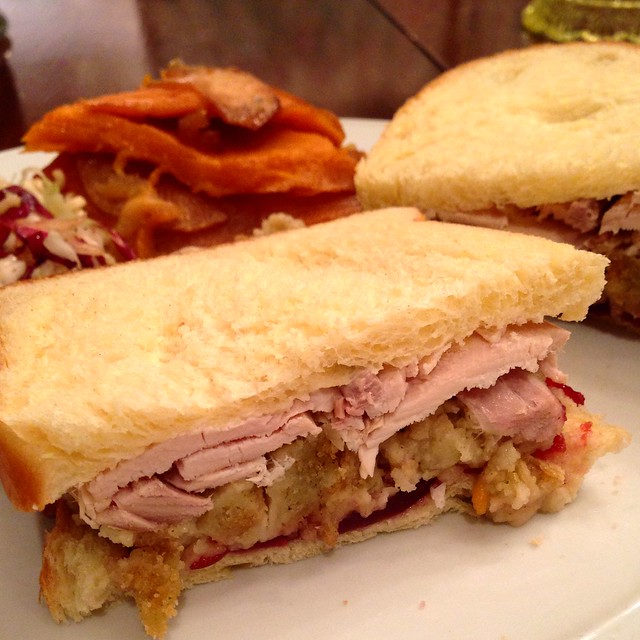Last month, Michigan State University history professor, Helen Veit, wrote a killer piece for The Atlantic on leftovers. While its title—“An Economic History of Leftoversâ€â€”won’t send pulses racing, its contents will. In fact, the piece should be required reading for anyone with a refrigerator. Yes, that means you. As a Tupperware-toting leftover lover, I just had to hear more about the process of researching and writing about this oh-so-polarizing topic. And with Thanksgiving’s surfeit of surplus nearly upon us, what better time to ponder leftovers than now?
Jonathan Bloom (JB): You’ve mentioned that researching leftovers was not terribly easy- why was that?
 Helen Veit (HV): Researching the history of leftovers was challenging for a couple of reasons. In the nineteenth century, people didn’t use the word “leftovers†or any other consistent term to describe food left behind from one meal to the next. People then dealt with leftovers all the time – constantly, in fact – but I had to do a lot of reading and skimming in early cookbooks to get a sense of people’s different strategies for using up leftover food. Even once the term “leftovers†was coined around the turn of the twentieth century, discussions of them appeared all over the place, not just in cookbooks or articles focused on leftovers exclusively. So I had to hunt for them.
Helen Veit (HV): Researching the history of leftovers was challenging for a couple of reasons. In the nineteenth century, people didn’t use the word “leftovers†or any other consistent term to describe food left behind from one meal to the next. People then dealt with leftovers all the time – constantly, in fact – but I had to do a lot of reading and skimming in early cookbooks to get a sense of people’s different strategies for using up leftover food. Even once the term “leftovers†was coined around the turn of the twentieth century, discussions of them appeared all over the place, not just in cookbooks or articles focused on leftovers exclusively. So I had to hunt for them.
JB: The advent of home iceboxes and, later, electric refrigerators brought revolutionary changes for leftovers. How did they alter our approach to leftovers in mindset and practice?
HV: Refrigeration transformed the way people approached leftovers. Cold storage let people preserve the same foods for days on end, even highly perishable foods like dairy, eggs, or meat. This meant that the identical meal could appear on tables over and over, making it more obvious to people that they were eating leftovers (instead of, say, having a stew incorporating scraps from yesterday’s dinner). Iceboxes and refrigerators relieved the pressure of having to use up foods immediately, but in turn this meant that a forgotten container of leftovers might languish in the back of the refrigerator for weeks. Another big result of home refrigeration was that within a single generation, American cooks stopped using a whole repertoire of home-preservation techniques like salting, smoking, drying, and pickling.
JB: Could it be that at some point, leftovers were actually…cool? When was that and what prompted that status?
HV: Working with leftovers – especially coming up with novel ways to repackage them, such as transforming them into an altogether new dish – was pretty fashionable for middle-class cooks in the middle of the twentieth century, roughly from the 1930s through the 1950s. Making leftovers appealing (and even fooling reluctant family members into eating them, if necessary) was a way for home cooks to show off their kitchen chops, their creativity, and their good domestic management skills.
JB: From what you discovered, what one person was the most significant proponent of leftovers?
HV: A lot of cookbook writers were singing the praises of leftovers in the mid-twentieth century, but one who sang louder than others was a cookbook author named Ruth Berolzheimer. Not too many people know about her today, but she was enormously popular in the mid-twentieth century. She was so popular, in fact, that she is still one of the bestselling cookbook authors in American history. Berolzheimer loved leftovers. She wrote at least one cookbook devoted exclusively to them – 500 Delicious Dishes from Leftovers, published in 1940 – and leftovers show up all the time in her more general cookbooks, too. She was an apostle of the idea that leftovers could be glamorous and cool, and that using up leftovers was a testing ground for cooks’ ingenuity.
JB: What’s one thing you enjoyed about researching leftovers and one that you didn’t?
HV: This project was really fun, and I can’t think of a low point. I can easily think of a high point, though: my favorite single moment was when I got to look through every single edition of The Joy of Cooking in the great culinary collection at Michigan State University.
JB: As a food historian, how do you assess public opinion on a certain topic, in this case, leftovers?
HV: Assessing public opinion – what regular people thought about any topic – is one of the trickiest things for historians to figure out, since most people historically did not leave written records about their thoughts on food or anything else. In this case, I did a lot of reading in newspapers, magazines, cookbooks, radio transcripts, home economics texts, and reports from government field workers. I also did some reading between the lines. For example, when I noted that in the 1960s people in large numbers started making jokes about the dreariness of leftovers and cookbook authors started feeling that they had to urge readers not to disdain leftovers, that was a sign to me that public opinion about leftovers was shifting.
JB: Are you a leftover lover? If so, what are your go-to moves? If not, what’s wrong with you?!? (kidding)
HV: As you guessed, I hate wasting food and I do my best to use up leftovers before launching into new cooking projects. My go-to move is lunch. Any leftovers from dinner get parceled out into lunchboxes, which usually makes for a healthier and cheaper meal than you’d get by eating out or turning to convenience foods, anyway. If I just have leftover odds and ends, I try to incorporate them in something like a soup or a stir-fry. This being said, however, I don’t mess around with food safety, and if a container of leftovers got overlooked for more than a few days, it goes into the compost.
JB: Your next book, Small Appetites, will be about how American children have become increasingly picky eaters. In your research, have you uncovered any guesses on how much pickier today’s children are and, thus, how much plate waste has increased in the last 50 or 100 years? And have you seen anything about decreased tolerance for leftovers amongst kids?
HV: Absolutely. Chronic pickiness was rare among children a hundred years ago and before. Obviously, that’s changed. Today, a child turning up his or her nose at a plate of food is a regular occurrence in many families, and that rejected food often gets thrown away. One thing that’s changed over the last hundred years is that food has become ever cheaper and more widely available for Americans, and tolerance of both plate waste and picky eating have increased as a result, for both children and adults. The idea that children don’t like leftovers has also been around for a while. Starting in the 1950s and 1960s, a powerful stereotype emerged about husbands and children not liking the leftovers that overeager wives and mothers were foisting upon them.



 Helen Veit (HV): Researching the history of leftovers was challenging for a couple of reasons. In the nineteenth century, people didn’t use the word “leftovers†or any other consistent term to describe food left behind from one meal to the next. People then dealt with leftovers all the time – constantly, in fact – but I had to do a lot of reading and skimming in early cookbooks to get a sense of people’s different strategies for using up leftover food. Even once the term “leftovers†was coined around the turn of the twentieth century, discussions of them appeared all over the place, not just in cookbooks or articles focused on leftovers exclusively. So I had to hunt for them.
Helen Veit (HV): Researching the history of leftovers was challenging for a couple of reasons. In the nineteenth century, people didn’t use the word “leftovers†or any other consistent term to describe food left behind from one meal to the next. People then dealt with leftovers all the time – constantly, in fact – but I had to do a lot of reading and skimming in early cookbooks to get a sense of people’s different strategies for using up leftover food. Even once the term “leftovers†was coined around the turn of the twentieth century, discussions of them appeared all over the place, not just in cookbooks or articles focused on leftovers exclusively. So I had to hunt for them.